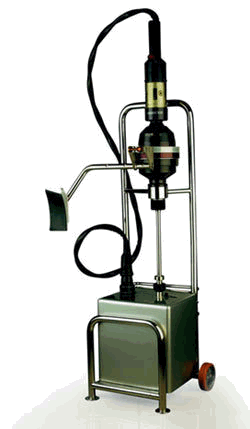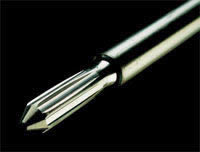Starter motor


Geared tip of the probe that is plugged into the back of the gearbox
Starter motor with external battery power supply
At the beginning of a race, a complex procedure is to start Formula One engine. Numerous components are utilized in this secretive action, without which the car would go nowhere. When you consider that a racing V8 using in F1 is around ten times more powerful than a road car power plant, you realize that it takes more than just the twist of a key to get it running.
The electrical starter motor is an external unit, held by a mechanic, which features a long probe that is plugged into the back of the gearbox and engage two pairs of gears. First of all, the mechanic inserts the probe in the gearbox. He then receives a signal to push the starter motor button. This turns the engine over until the engineers are happy with the engine speed and oil pressure and - using a laptop - they will effectively turn the ignition on.
In simple terms, when he pushes the starter motor's button, 24 volts start an handheld electric motor and trough long shaft start to turn gearbox and through the gearbox to turn the engine. Because the motor has such a kick in it, there is a reaction arm which hooks up on to the rear wing or to the road to stop it coming out of the mechanic's hand.
The starter motor features a set of gears and clutch, and as the engine will move five times faster than this, for safety there is a spring clutch. This acts like the freewheel on a bicycle, allowing the mechanic to withdraw the probe without any danger to himself. Another safety measure is the break-off clutch, which will prevent an accident should the engine backfire.
While the starter motor itself is an off-the-shelf unit, modified to cope with the high voltage passed through it, the probe, gears, clutch and electronics are all produced in-house by the teams.
A range of materials are used for the construction, including aluminium for the main body and steel for the probe.
The starter is made to be reliable, not light, which is one of the benefits of having an external unit. In the past, when they had an on-board starter, they wanted it to be as light as possible so an air starter was used. Now they concentrate on durability and this is generally a trouble-free piece of equipment.
From season 2014 and massive engine and KERS rule change, FIA included in their Formula 1 rule book that an starter motor must be included and that driver must be able to start the engine seated in the cockpit.
5.18 Starting the engine :
It must be possible for the driver to start the engine at any time when seated normally at the wheel and without any external assistance.






